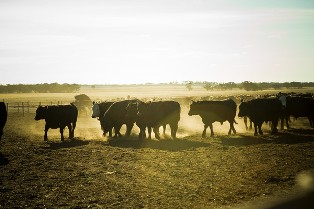Bovine Ephemeral Fever, commonly known as 3 day sickness, is a significant disease affecting cattle in northern Australia. It is caused by a virus and transmitted by mosquitoes and biting midges. It is often seen after heavy rainfall and flooding which provides favourable conditions for insect populations to increase.
The disease manifests in three stages. Stage one includes sudden onset fever, shivering, depression, abnormal posture, drooling, discharge from eyes and nostrils, Cow down with 3 day sickness reduced feed intake, and diminished milk production.

The second stage presents as muscle stiffness, lameness (with joints visibly swollen), and possible secondary bloat.
The third stage is the development of secondary complications. Due to their weight bulls, bullocks and pregnant cows are susceptible to nerve and muscle damage in their limbs if they go down. Pneumonia may develop due to impacts on the nerves that control swallow, allowing food, water or saliva to enter the lungs. Being down also increases the risk of pneumonia developing. Effects on reproduction may be noted; cows in late pregnancy may abort and bulls are commonly rendered infertile for three to six months.
Diagnosis relies on clinical signs and its rapid spread through herd. The virus can be cultured from a blood sample, detected through PCR tests or antibody analysis via paired blood samples (one taken during the first stage when the fever is established and the second taken 14 days later).
Animals develop long-lasting immunity after natural exposure to the disease.
Control measures include vaccination, administered twice initially (2 weeks to six months apart), with annual boosters ideally given 8-10 weeks before high risk periods (the wet season in northern Australia).
If 3 day sickness is suspected, seek veterinary advice as there are several other diseases with similar symptoms which require alternative treatments. Anti-inflammatory drugs can reduce the course of the disease, and calcium injections aid recovery. To help livestock recover, it is critical to provide feed, water and shelter.
Deaths are uncommon but do occur. Early intervention and aggressive treatment lead to a quicker recovery and less weight loss.
More information:
- Consult your local veterinarian or beef advisor
- Bovine ephemeral fever | Business Queensland
- Three day sickness of bovine ephemeral fever | Northern Territory
- Managing Bovine Ephemeral Fever (“three day sickness”) | FlyBoss
Acknowledgement: This article is courtesy of Future Beef



